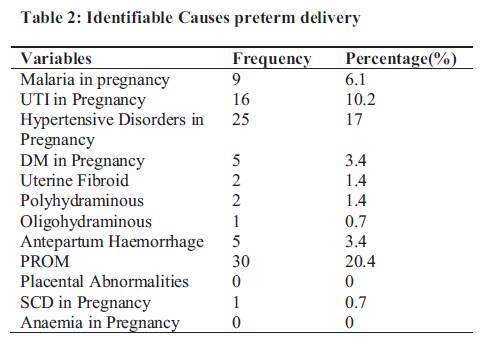Prevalence and risk factors for preterm delivery in UNIOSUN Teaching Hospital, Osogbo - A 5 year retrospective review
DOI:
https://doi.org/10.4314/rejhs.v11i2.3Keywords:
Preterm delivery, Causes, Risk factors, PrevalenceAbstract
Introduction: Preterm delivery is the leading cause of death in the neonatal period. It causes 28% of perinatal mortality. In Nigeria, it is responsible for 40-60% of perinatal morbidity. According to a U.S. research, preterm births have surged globally. In 2016, 16.8% of singleton live births in Lagos, Nigeria, were preterm.
Methods: It was a retrospective review of patients with singleton preterm delivery in UNIOSUN Teaching Hospital, Osogbo from July 2013 to June 2018. Case records of mothers/patients with preterm deliveries were retrieved. Information on the patients' age, parity, educational status, weight, body mass index, number of antenatal visits, identifiable causes of preterm delivery and others were all extracted.
Result: During the research period, 2,234 babies were born, including 210 preterm singletons out of which 147 were reviewed. Singleton preterm birth prevalence was 9.4%.Of the 147 mothers, n (20.4) had premature rupture of membrane (PROM), hypertensive disorders in pregnancy occurred in n(17.0%), Urinary Tract Infection (10.8%) and malaria in pregnancy (6.1%).
Conclusion: Preterm birth rates were low compared to recent rates in the country. PROM, malaria in pregnancy, UTI in pregnancy, hypertensive disorders in pregnancy and previous history of spontaneous miscarriage were important causes/risk factors for preterm delivery.
References
Adibe, M.O., Aluh, D.O., Isah, A., Anosike, C.(2017). Knowledge, Attitude and Perception among Male Staff in the university of Nigeria. Asian Pacific Journal of Cancer.2017; 18(7):1961–1966.
Mofolo N, Betshu O, Kenna O, et al (2015). Knowledge of prostate cancer among males attending a urology clinic, a South African study. Springerplus, 4, 67.
Wanyagah, P., (2013). Prostate cancer awareness, knowledge, perception o1. As h e l y S. Roma n . La t e p r e g n a n c y complications. Current diagnosis and treatment in Obstetrics and gynaecology, Lancet 2013; (11): 251-255
Lawn JE, Wilczynska-Ketende K, Cousens SN. Estimating the causes of 4million neonatal deaths in the year 2000. Int J Epidemiol 2006; 35:706-18
Olugbenga A. Mokuolu, BM Suleiman, OO Adesiyun, and A Adeniyi . Prevalence and determinants of pre-term deliveries in the University of Ilorin Teaching Hospital, Ilorin, Nigeria. Paediatrics reports 2010 18; 2(1):Published online 2010 Jun 18.
Lawn JE, Cousens SN, Darmstadt GL, Bhutta ZA, Martines J, Paul V, et al., 1 year after The Lancet Neonatal Survival Series-was the call for action heard? Lancet 2006; 367: 1541
Vogel JP, Lee AC, Souza JP Maternal morbidity and preterm birth in 22 low- and middle-income countries: a secondary analysis of the WHO Global Survey dataset. BMC Pregnancy Childbirth. 2014 31;14:56.
Callaghan WM, MacDorman MF, Rasmussen SA, Qin C, Lackritz EM. The contribution of preterm birth to infant mortality rates in the United States. Int J Pediatr 2006 ;118(4):1566-73.
Steer P. The epidemiology of preterm labour. BJOG 2005;112:1–3.
Demissie K, Rhoads GG, Ananth CV, Alexander GR, Kramer MS, Kogan MD, Joseph KS. Trends in preterm birth and neonatal mortality among blacks and whites in the United States from 1989 to 1997. Am. J. Epidemiol 2001 ;154(4):307-15.
Butali, A., Ezeaka, C., Ekhaguere, O., Weathers, N., Ladd, J., Fajolu, I., et al Characteristics and risk factors of preterm births in a tertiary center in Lagos, Nigeria. Pan Afr Med J. 2016 May 1;24:1
Blencowe H, Cousens S, Chou D, Oestergaard M, Say L, Moller AB, Kinney M. et al; Born too soon: the global epidemiology of 15 million preterm births. PUB MED 2013;10 Suppl 1:S2. doi: 10.1186/1742-4755-10-S1-S2.
Newburn-Cook CV, Onyskiw JE: Is older maternal age a risk factor for preterm birth and fetal growth restriction? A systematic review. Health care Women International 2005 26(9):852-75.
Hanna R, Kieron B, Pekka M, Mikko M: Advanced Maternal Age and the Risk of Low Birth Weight and Preterm Delivery: a Within-Family Analysis Using Finnish Population Registers. Am. J. Epidemiol, Volume 186, Issue 11, 1 December 2017, Pages 1219–1226
Mokuolu AO, Abdul IF, Adesiyun O. Maternal factors associated with early spontaneous singleton preterm delivery in Nigeria. Trop J Obstet Gynaecol. 2002;19:32–5.
Iyoke CA, Lawani LO, Ezugwu EC, Ilo KK, Ilechukwu GC, Asinobi IN. Maternal risk factorsn self- vulnerability and uptake of screening among men in Nairobi County, Kenya.. for singleton preterm births and survival at the University of Nigeria Teaching Hospital, Enugu, Nigeria. Niger J Clin Pract 2015;18:744-50
Aziken ME, Akubuo KK, Gharoro EP. Efficacy of intermittent preventive treatment with sulfadoxine-pyrimethamine on placental parasitemia in pregnant women in Midwestern Nigeria. Int J Gynaecol Obstet. 2011;112 (1):30-3
Albertsen K, Andersen AM, Olsen J, Grønbaek M. Alcohol consumption during pregnancy and the risk of preterm delivery. Am. J. Epidemiol; 2004 Jan 15;159 (2):155-61.
Kosa JL, Guendelman S, Pearl M, Graham S, Abrams B, Kharrazi M. The association between pre-pregnancy BMI and preterm delivery in a diverse southern California population of working women. Matern Child Health J; 2011 Aug;15(6):772-81.

Downloads
Published
How to Cite
Issue
Section
License
Copyright (c) 2023 Research Journal of Health Sciences

This work is licensed under a Creative Commons Attribution-NonCommercial-NoDerivatives 4.0 International License.
Research Journal of Health Sciences journal is a peer reviewed, Open Access journal. The Journal subscribed to terms and conditions of Open Access publication. Articles are distributed under the terms of Creative Commons License (CC BY-NC-ND 4.0). (http://creativecommons.org/licences/by-nc-nd/4.0). All articles are made freely accessible for everyone to read, download, copy and distribute as long as appropriate credit is given and the new creations are licensed under the identical terms.





